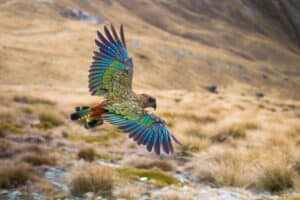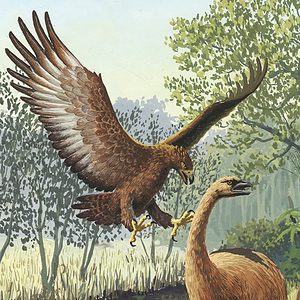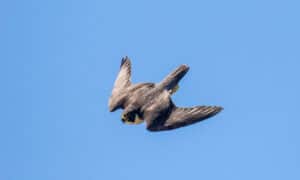As the oldest living ecosystems, rainforests have existed for millions of years. Their moisture-dependent vegetation attracts many unique and colorful creatures, especially birds. Discover 12 colorful types of rainforest birds below! Learn about their locations, appearance, diet, vocalizations, and behavior.
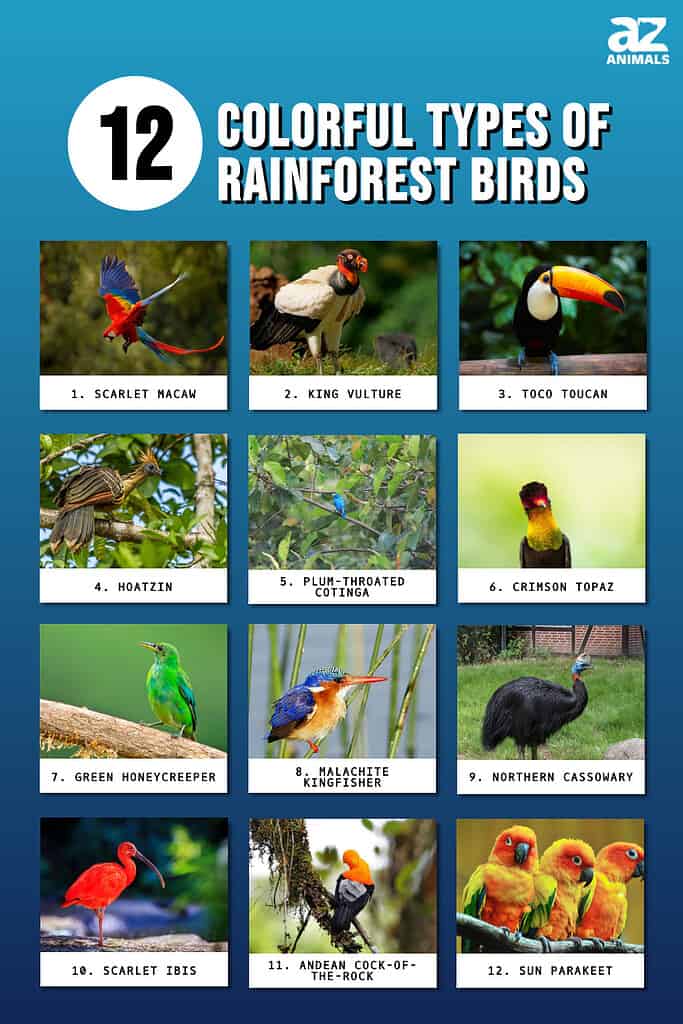
1. Scarlet Macaw
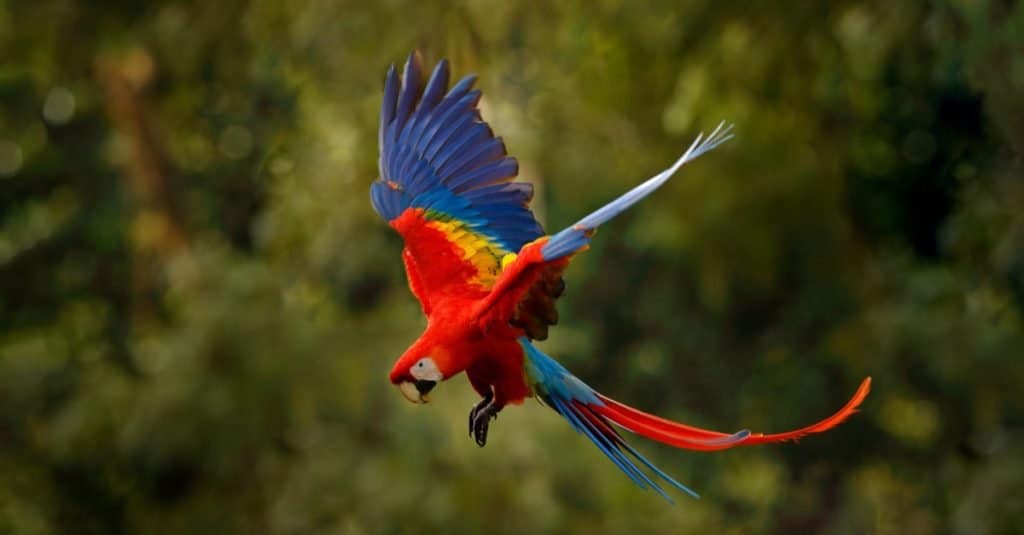
This macaw has striking, bright plumage and a long, pointed tail.
©Ondrej Prosicky/Shutterstock.com
Location: Scarlet macaws are birds of the neotropics. They inhabit humid evergreen forests from Mexico to Venezuela and Brazil. You can also find these birds in the Amazon rainforest, open woodlands, savannas, and river edges.
Appearance: This macaw has striking plumage and a long, pointed tail. Their feathers are a rainbow of bright red, yellow, blue, white, and black.
Diet: Macaws eat fruits, nuts, seeds, flowers, and nectar.
Vocalizations: Their loud calls feature raucous honks and mimicry.
Behavior: They live alone or in pairs above the forest canopy.
2. King Vulture
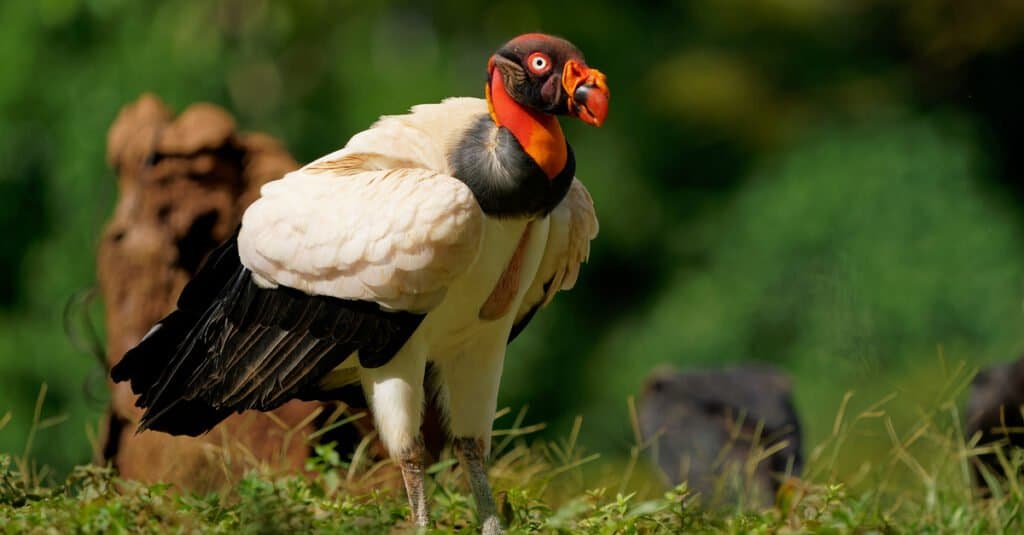
King vultures live in Central and South America in tropical lowland forests.
©Martin Pelanek/Shutterstock.com
Location: King vultures live in Central and South America, where they inhabit tropical lowland forests, including the Amazon Rainforest.
Appearance: They are one of the largest vultures in the New World, with a wingspan reaching up to 7 feet. Their body plumage is monochromatic gray and black, while their faces are bare. Instead of feathers, their faces display red, yellow, and blue skin!
Diet: They are scavengers, eating carrion and taking advantage of injured animals.
Vocalizations: Strange, low croaking and wheezing noises pair nicely with this bird’s odd appearance.
Behavior: King vultures soar effortlessly for hours, barely flapping their wings. They are non-migratory and live alone or in small family groups.
3. Toco Toucan

Toco toucans inhabit open areas along the Amazon River and live in savannas, woodlands, and coastal regions.
©SJ Travel Photo and Video/Shutterstock.com
Location: The toco toucan, also known as the common toucan, is found in Central to Eastern South America. They inhabit open areas along the Amazon River. But you can also find them in savannas, woodlands, and coastal regions.
Appearance: They are the largest species in the toucan family and possess mainly black plumage with bright red, orange, and yellow beaks and blue eye rings.
Diet: Their favorite foods are fruits, insects, frogs, reptiles, and small birds.
Vocalizations: These goofy looking birds grunt and emit snoring sounds.
Behavior: You will find them in pairs or small groups nesting high in trees.
4. Hoatzin
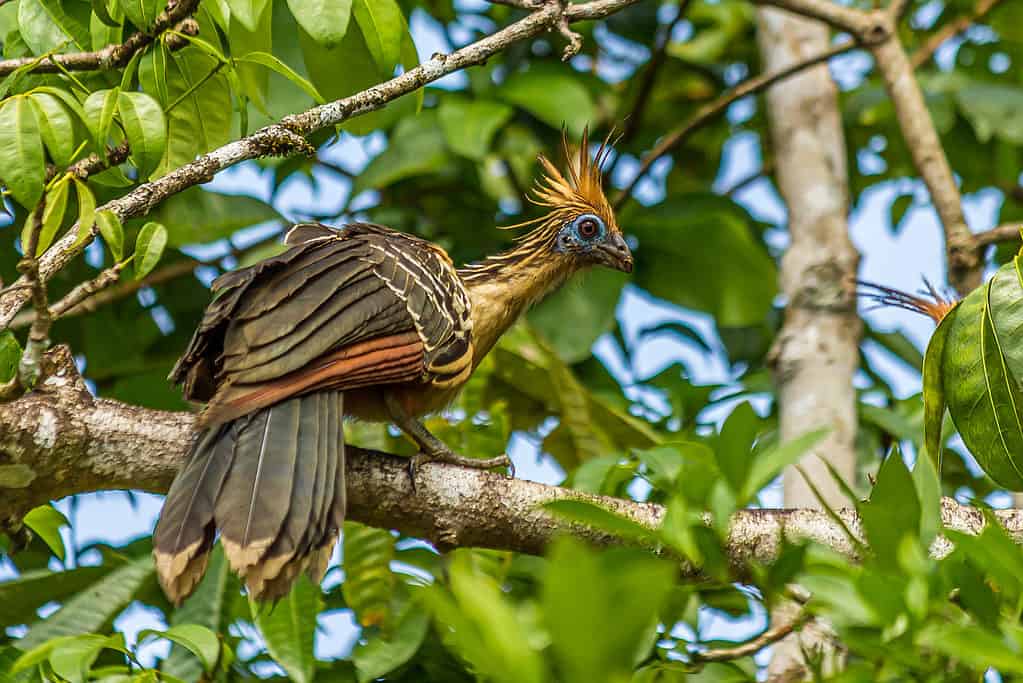
The hoatzin is an unusual-looking pheasant-sized bird of the Amazon and Orinoco Basins.
©Dmitrii Kash/Shutterstock.com
Location: The unusual-looking hoatzin lives in Northeastern South America, inhabiting the Amazon and Orinoco Basins. They live in swamps, mangroves, and riparian forests.
Appearance: They are about the size of a pheasant with long necks and small heads. They also have large, erect crests, bright red eyes, and blue skin on their faces. Additionally, their plumage is dark gray, white, buff, and deep red.
Diet: They love to snack on leaves and fruits.
Vocalizations: These weird birds make weird noises as well: groans, croaks, hisses, and grunts!
Behavior: They move around in the trees and form large flocks.
5. Plum-Throated Cotinga
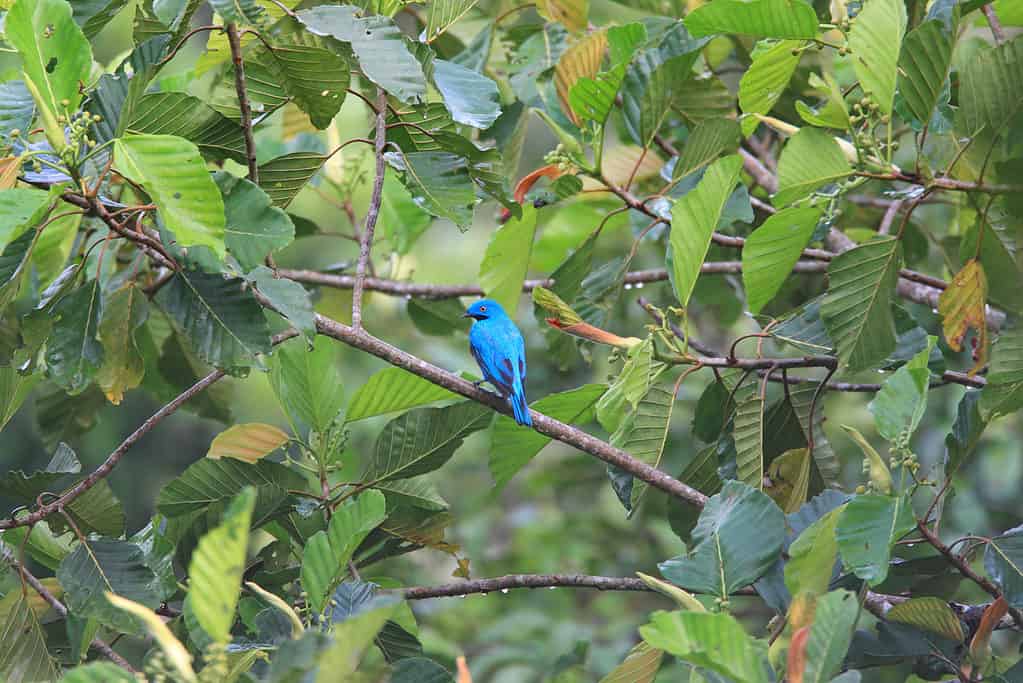
Plum-throated cotingas live in tropical rainforests in South America as well as swamps and degraded former forests.
©iStock.com/feathercollector
Location: Plum-throated cotingas inhabit parts of Western South America, where they live in tropical lowland forests, swamps, and heavily degraded former forests.
Appearance: These brightly colored birds have relatively short tails and large, round eyes. Their plumage displays the brightest shade of blue, along with a bit of black.
Diet: Fruit and small insects make up the majority of their diet.
Vocalizations: Interestingly, their song is unknown. But they make a twittering noise with their wings.
Behavior: They have quiet, subdued personalities and feed in mixed flocks with parrots.
6. Crimson Topaz
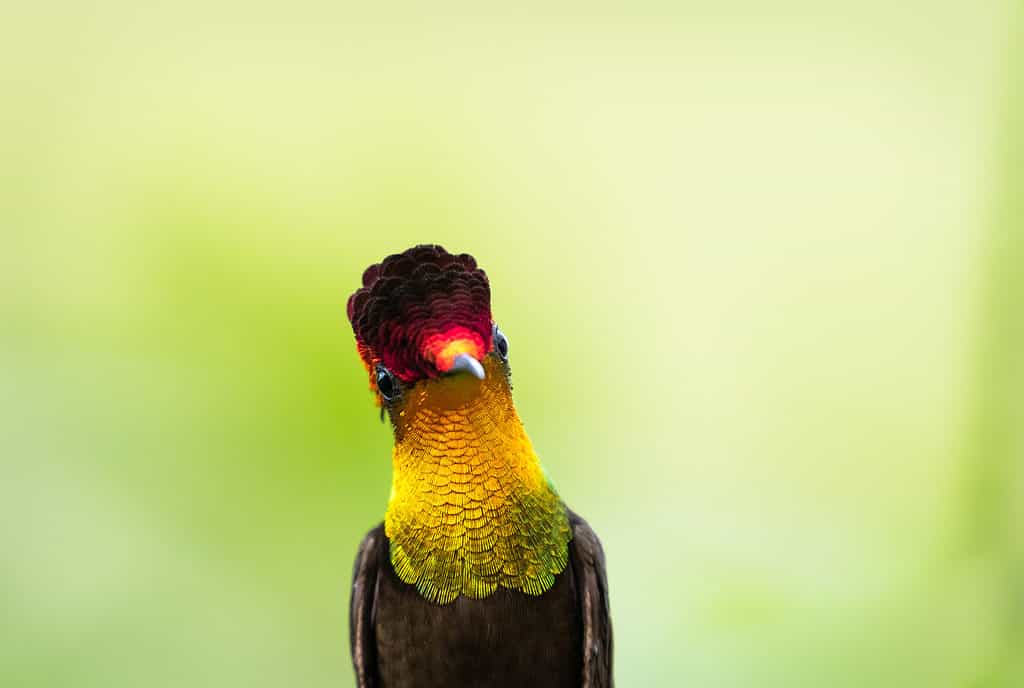
The topaz
hummingbird
lives in lowland rainforests in Northeastern South America.
©iStock.com/Chelsea Sampson
Location: The crimson topaz is found in Northeastern South America and inhabits the interior of rainforests in lowlands and foothills.
Appearance: They are small in general, but they are also the second-largest hummingbird species. Along with slightly decurved bills, these beauties look like they’re dressed for Mardi Gras. They have gorgeous multi-colored iridescent feathers in shades of golden green, bright red, chestnut, black, brown, bronze, violet, and dark green.
Diet: Nectar is their main source of nourishment.
Vocalizations: They often chatter irregularly.
Behavior: They are mainly sedentary in their range, but will move locally to find flowering plants.
7. Green Honeycreeper
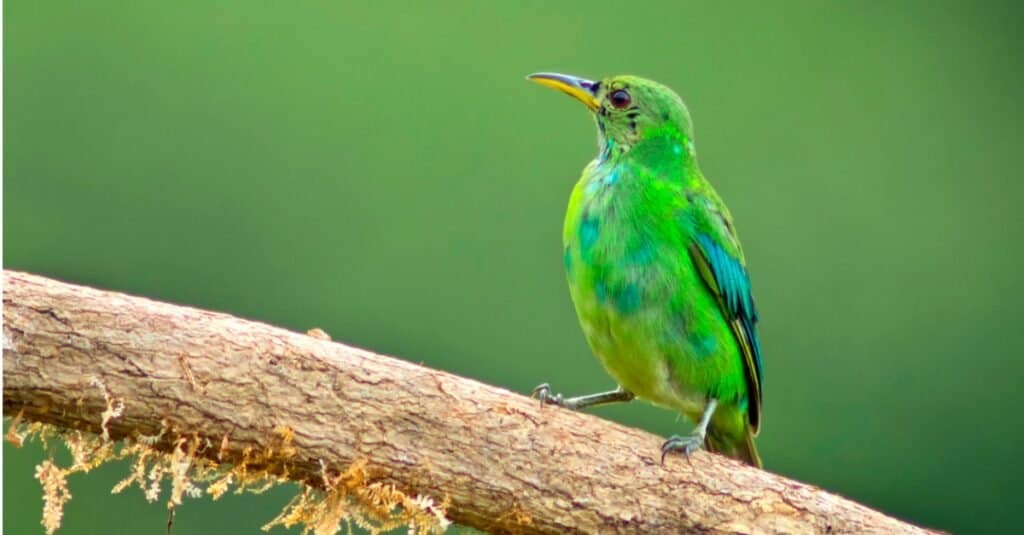
The brightly colored green honeycreeper eats fruits, seeds, nectar, and insects.
©iStock.com/Alberto Carrera
Location: The green honeycreeper has a significant range across Northern and Western South America, where they live on the edges of tropical rainforests.
Appearance: These small birds have short tails and long bills. They also have bright green to turquoise plumage with black heads and yellow bills.
Diet: Honeycreepers eat fruits, seeds, nectar, and insects.
Vocalizations: They emit sharp chips.
Behavior: In the forest canopy, they feed alone or in pairs.
8. Malachite Kingfisher
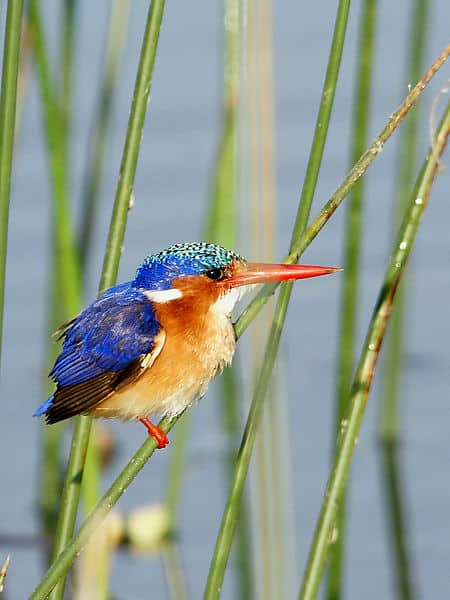
Malachite kingfishers are native to Sub-Saharan
Africa
.
©© Hans Hillewaert / CC BY-SA 4.0 – License
Location: The malachite kingfisher lives in Sub-Saharan Africa, where it inhabits a variety of areas, such as swamps, marshes, estuaries, mangrove forests, and aquatic vegetation near slow-moving rivers.
Appearance: These tiny kingfishers have short blue and black crests. They are rich blue above and white and rufous below, with reddish-orange beaks and feet.
Diet: They prefer to consume small fish, insects, and crustaceans.
Vocalizations: Listen for their short, shrill repeated calls.
Behavior: They sit on low perches over the water, diving suddenly to grab struggling prey.
9. Northern Cassowary
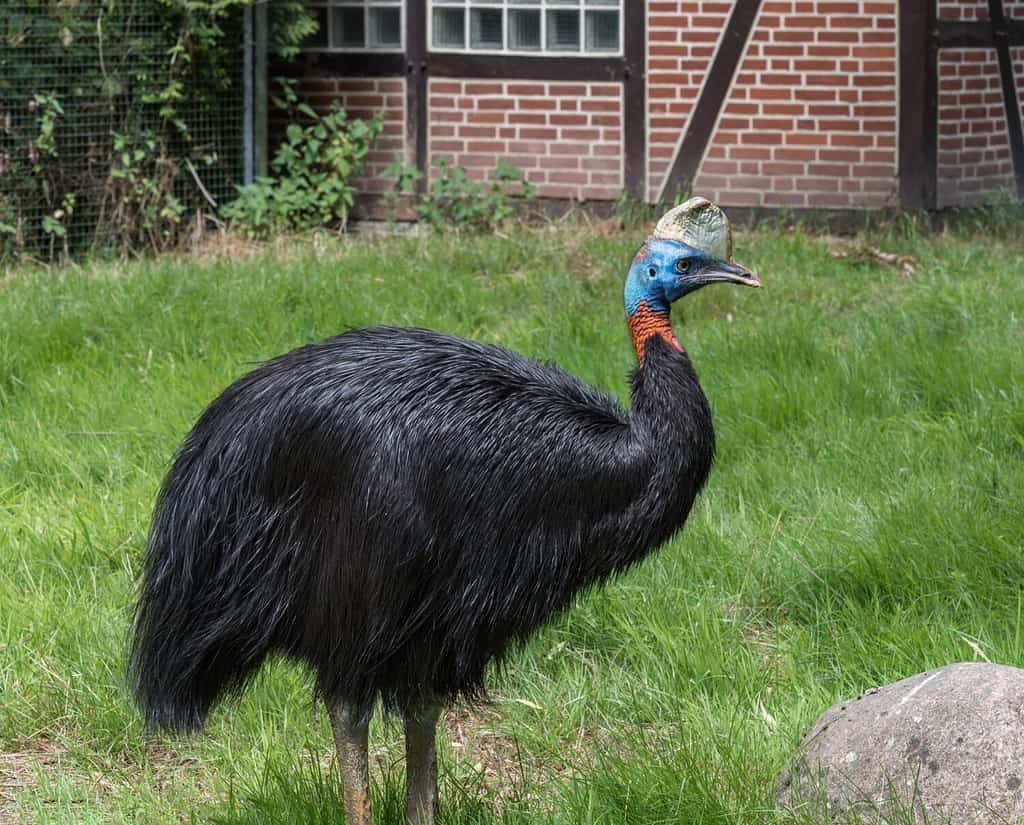
The northern cassowary is a shy, solitary, and unpredictable bird.
©NataliaVo/Shutterstock.com
Location: The northern cassowary lives in Northern New Guinea, where it inhabits humid areas, such as lowland swamps and coastal rainforests.
Appearance: These birds are large and flightless with stiff black plumage and giant feet. In fact, their feet are comically huge! They have bright orange necks and blue facial skin. Interestingly, it is the fourth heaviest living bird species.
Diet: They forage for berries and fruits, and hunt small mammals, reptiles, and insects.
Vocalizations: These big-footed birds make grunting and hissing sounds.
Behavior: They are shy and solitary birds but can be unpredictable, occasionally kicking their massive, clawed feet.
10. Scarlet Ibis
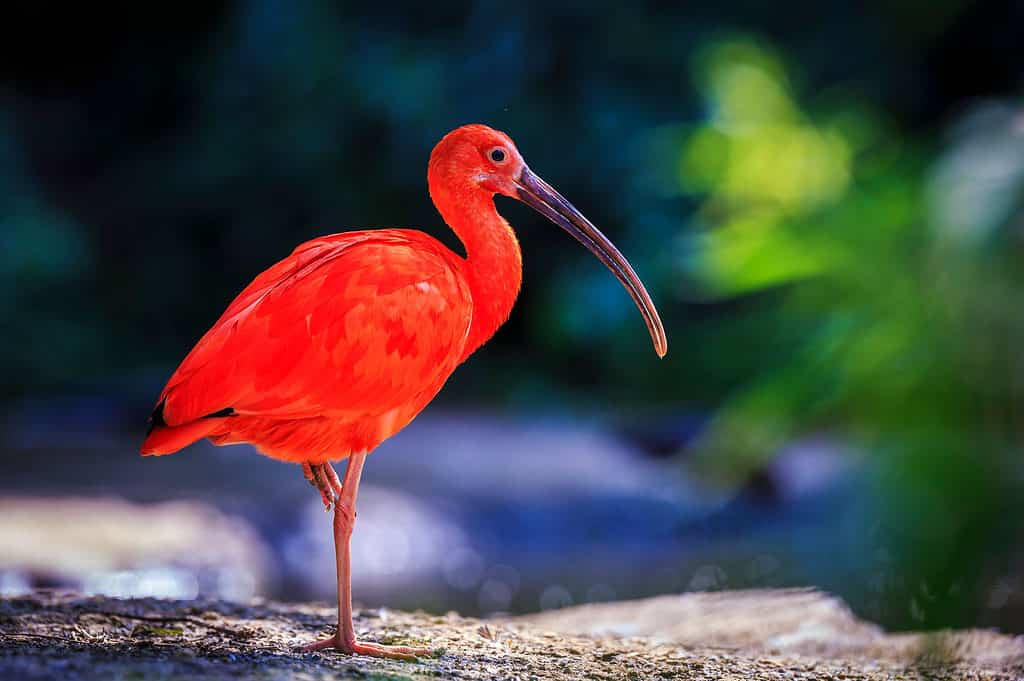
The scarlet ibis lives in tropical South America and the Caribbean in many aquatic habitats.
©SanderMeertinsPhotography/Shutterstock.com
Location: The stunning scarlet ibis is native to tropical South America and the Caribbean. They live in aquatic habitats, such as wetlands, tidal mudflats, mangrove swamps, and marshes.
Appearance: Adults are scarlet all over, but vary in tints and shades. Their bills are mostly red but turn blackish at the end. Additionally, they have heavy-looking bodies, long thin legs, and downward-curved beaks.
Diet: They search for insects, fish, and crustaceans.
Vocalizations: These super pink birds grunt and croak!
Behavior: They are migratory and strong fliers but prefer to stay on foot, wading in shallow water.
11. Andean Cock-of-the-Rock
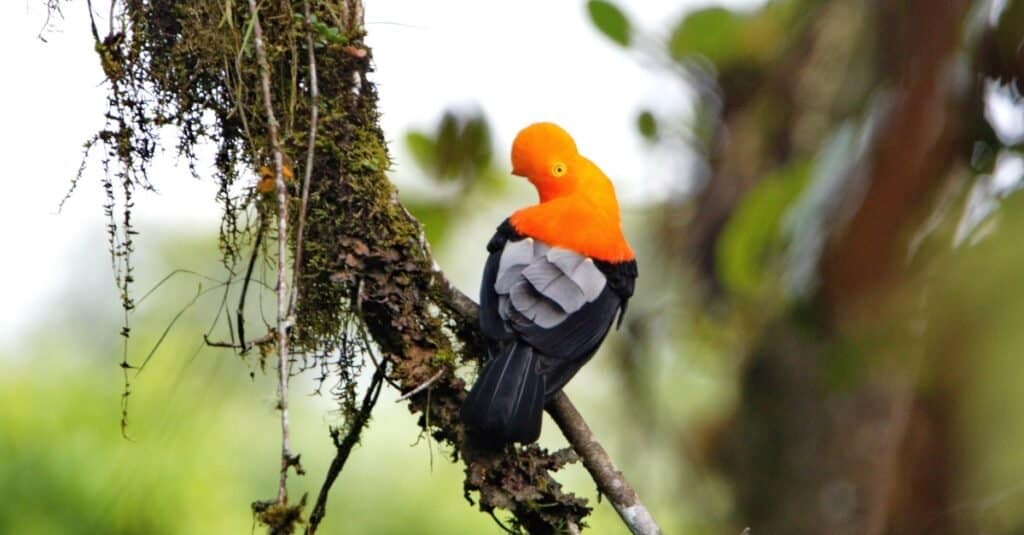
The Andean cock-of-the-rock is native to the Andes of Western South America, where they live in humid cloud forests.
©iStock.com/ANPerryman
Location: The Andean cock-of-the-rock is an odd-looking bird found in the Andes of Western South America. They live in humid, rocky cloud forests in ravines near forest streams.
Appearance: If their shocking orange plumage isn’t enough to grab your attention, their large disc-like crests will! Though the top portion of these passerine birds is quite vivid, their tails and wings are simply black and gray.
Diet: They consume primarily fruits and insects.
Vocalizations: Andeans are typically quiet, but males make strange noises during the breeding season.
Behavior: They are fairly shy and hard to spot, except during courtship when males squawk, jump around, and snap their bills.
12. Sun Parakeet
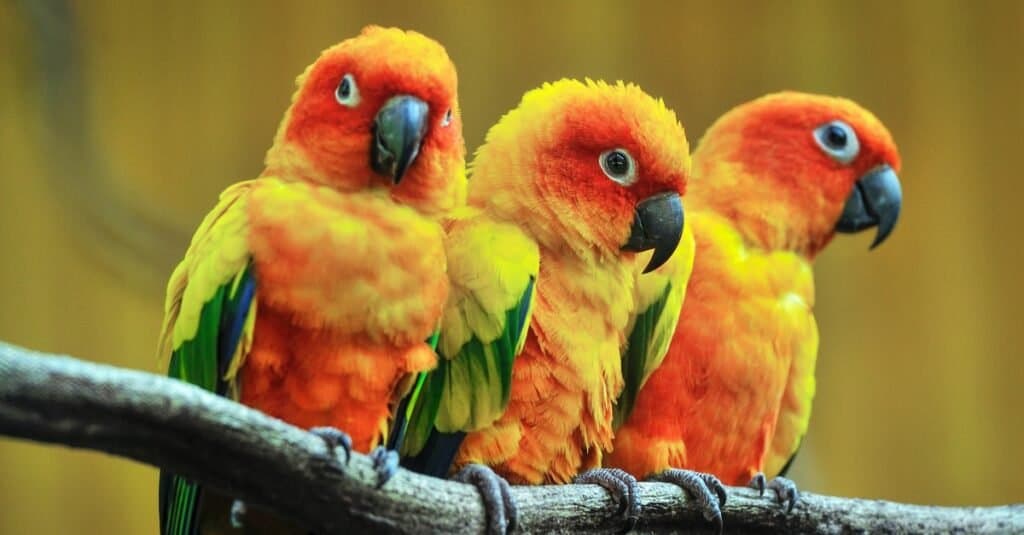
Their feathers are bursting with color, in neon shades of yellow, orange, red, blue, and green.
©Yatra/Shutterstock.com
Location: Sun parakeets are native to Northeastern South America in a relatively small region. They live in tropical habitats, such as woodlands, savannas, and scrublands along forest edges.
Appearance: They are medium-sized parrots with long tails and vibrant plumage. Their feathers are bursting with color, in neon shades of yellow, orange, red, blue, and green. In contrast, they have white eye circles and black beaks.
Diet: These stunningly vibrant birds eat fruits, flowers, berries, blossoms, seeds, nuts, and insects.
Vocalizations: They emit high-pitched screams, singing, and chirping.
Behavior: These birds are playful and highly social, often living in large flocks in the wild.
Summary of 12 Colorful Types of Rainforest Birds
Here’s a recap of the dozen bright and beautiful birds living in rainforests that we took a look at.
| Number | Bird | Range |
|---|---|---|
| 1 | Scarlet Macaw | Humid evergreen forests from Mexico to Venezuela and Brazil; also in the Amazon rainforest |
| 2 | King Vulture | Central and South America in tropical lowland forests, including the Amazon Rainforest |
| 3 | Toco Toucan | Central to Eastern South America; open areas along the Amazon River |
| 4 | Hoatzin | Northeastern South America, inhabiting the Amazon and Orinoco Basins |
| 5 | Plum-Throated Cotinga | Western South America |
| 6 | Crimson Topaz | Northeastern South America |
| 7 | Green Honeycreeper | Northern and Western South America |
| 8 | Malachite Kingfisher | Sub-Saharan Africa |
| 9 | Northern Cassowary | Northern New Guinea |
| 10 | Scarlet Ibis | Native to tropical South America and the Caribbean |
| 11 | Andean Cock-of-the-Rock | In the Andes of Western South America |
| 12 | Sun Parakeet | Native to Northeastern South America |
The photo featured at the top of this post is © iStock.com/Kevin Kaiser
Thank you for reading! Have some feedback for us? Contact the AZ Animals editorial team.



